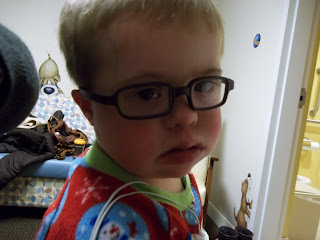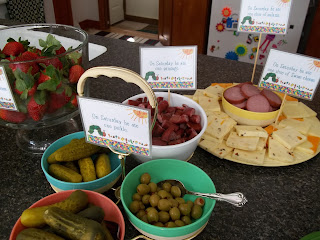Last night Little Dude had a Sleep Study. For those of you that either didn't know he was having one or don't know what they're about, here's the Reader's Digest version:
Individuals with Ds have a higher than average incidence of sleep apnea and certain other issues.
In general, individuals with Ds tend to have a smaller facial structure, lower-set ears, lower muscle tone (including facial muscles), and a few other things that can make an obstruction more likely. Because of this, the American Academy of Pediatrics standard of care for children with Ds is that they should have a Sleep Study by age 4.
At Little Dude's age, should his study show apnea, the first mode of treatment is removing his tonsils and adenoids. He is already scheduled to get ear tubes placed in a few weeks, so the T&A would be performed at that time if necessary.
Our night went something like this:
We arrived at the clinic at 7pm. We were shown to our room, which has a bed or crib for the patient, a small couch/bed for the parent, and an attached bathroom. They can do 4 patients per night. Last night there were all little boys. After giving you a few minutes to get use to the room, the technician comes in to start the wiring process.
The patient is wired from head to toe, literally. A pulse oximeter is placed on the big toe. This was a source of great entertainment for Little Dude and he took great pleasure in using the red light as a flashlight, sticking it in my face so I could see, shining it under and through the blankets, etc.
There are sensors on the legs to tell how much kicking occurs.
There are several different belts and sensors on the outside of the pajamas as well as a heart rate monitor, etc. on the skin.
There are sensors near the eyes that detect when the patient enters REM (rapid eye movement) sleep.
Sensors on the jaw detect if the child grinds his teeth as well as help tell when he falls asleep as the muscles become slack.
EEG leads are applied to the head.
The 2 most important parts of the study go under the nose. One is a small microphone that picks up snoring, etc. The second is a nasal canula which monitors the breathing.
Oh, and the beloved ceiling camera... everything is being watched.
 |
the finished product
|
The wiring process took the better part of an hour. Because the nasal sensors
need to not be disturbed, the tech wanted to put no-nos on Little Dude. (No-nos are arm immobilizers that keep the elbows straight so kids can't pull on tubes.) I vetoed this idea with the promise that I'd agree to them
if Little Dude didn't obey.
I explained that if he played with the sensors, he wasn't going to like the consequences. And in true Little Dude fashion, he didn't touch them
with his hands. But boy oh boy, he sure did try to with his giraffe-length tongue.
While he'll go into bed awake at home, he wanted none of that last night. The combo of a strange environment, all of the leads, and a long nap on the drive down were working against us.
I rocked him for a long time, but everytime he fell asleep and I tried to put him into the crib, he awakened. Eventually, we both ended up in the bed. Lying there knowing you're being watched, there is a strong urge to do something goofy for the camera. I resisted.
About 11pm I was able to move to my own bed, but after I did, I was wishing I had stayed with Little Dude because he definitely got the better bed last night. (And this is from a girl who can sleep anytime, anywhere.)
The tech was in the room several times during the night to adjust wires Little Dude had disturbed while sleeping. Overall, despite his nasal congestion, nap on the drive there, strange environment, and wires, Little Dude slept pretty well.
 |
| the morning after |
No worse for the wear, he was his old chatty self by the time we walked to the car at 6am.
I am so very thankful for both the level of healthcare and access to it that we enjoy here in the United States. We are truly blessed.






















